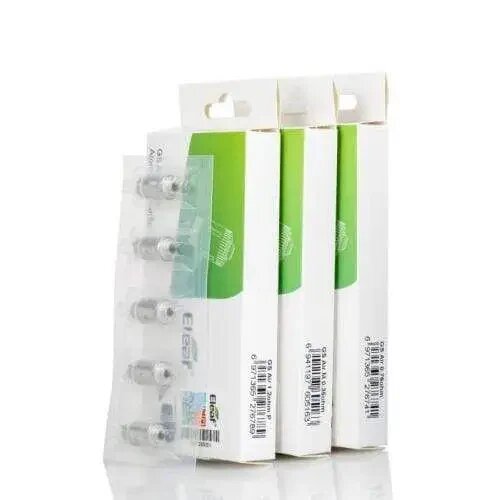When it comes to vaping, the coil is the heart of your device, and Eleaf coils are among the most popular choices for vapers. Whether you’re a seasoned vaper or just starting out, knowing the ins and outs of Eleaf coils can enhance your vaping experience. This guide will provide you with a thorough understanding of Eleaf coils, including their types, features, and maintenance tips.
What Are Eleaf Coils?
Eleaf coils are essential components used in Eleaf vape tanks. They are in charge of heating the e-liquid and vaporizing it. Made from various materials like kanthal, stainless steel, and nickel, these coils come in different resistance levels to cater to different vaping preferences. The choice of coil can significantly impact your vaping experience, affecting flavor, vapor production, and overall satisfaction.
Types of Eleaf Coils:
1. EC Coils:
The EC series is one of the most popular types of Eleaf coils. Known for their excellent flavor and vapor production, EC coils are available in various resistances to suit different vaping styles. The EC coils are designed with a large surface area to provide a smooth and satisfying vape. They are compatible with several Eleaf tanks, including the Melo series.
2. LVC Coils:
The LVC (Liquid Valve Control) coils are designed with an adjustable liquid valve, allowing vapers to control the flow of eliquid to the coil. This feature helps in fine-tuning the vape experience, especially for those who prefer a more customized setup. The LVC coils are ideal for high-VG e-liquids, providing a rich and dense vapor.
3. GT Coils:
GT coils are another popular choice among Eleaf users. These coils are engineered for durability and performance, offering a balance between flavor and vapor production. GT coils are available in various resistances, catering to different vaping preferences, from direct lung hits to mouth-to-lung styles.
4. HW Coils:
The HW series is known for its high-wattage capability and impressive vapor production. These coils are designed to handle higher power levels, making them suitable for sub-ohm vaping. The HW coils deliver intense flavor and thick clouds, making them a favorite among cloud chasers.
Features of Eleaf Coils:
1. Material Quality:
Eleaf coils are made from high-quality materials to ensure longevity and optimal performance. The use of stainless steel, kanthal, and other materials helps in providing a consistent vaping experience. Each material has its own benefits, such as improved heat resistance or better flavor production.
2. Resistance Levels:
The resistance of a coil plays a crucial role in determining the type of vape experience you’ll have. Lower resistance coils (sub-ohm) are designed for high-wattage vaping and produce larger vapor clouds, while higher resistance coils are better suited for mouth-to-lung vaping and offer a more restricted airflow.
3. Wicking Material:
The wicking material used in Eleaf coils helps in absorbing and delivering e-liquid to the coil. Common wicking materials include cotton and ceramic. Cotton provides excellent flavor and vapor production, while ceramic wicks offer longer-lasting performance and cleaner flavor.
4. Compatibility:
Eleaf coils are designed to be compatible with specific Eleaf tanks. It’s essential to ensure that the coil you choose matches the tank you’re using to achieve the best performance. For compatibility, always refer to the manufacturer’s guidelines.
How to Install Eleaf Coils:
Installing Eleaf coils is a straightforward process, but it requires some attention to detail to ensure optimal performance. Here’s a step-by-step guide:
-
Disassemble the Tank: Start by removing the tank from your vape device. To reach the coil, unscrew the tank’s base.
-
Remove the Old Coil: Carefully unscrew the old coil from the base. If the coil is stuck, gently wiggle it to loosen it.
-
Prime the New Coil: Before installing the new coil, drip a few drops of e-liquid onto the cotton wicking material to ensure it’s saturated. This step helps prevent dry hits and prolongs the coil’s lifespan.
-
Install the New Coil: Screw the new coil into the base of the tank. Make sure the fit is snug but not too tight.
-
Reassemble the Tank: Put the tank back together and fill it with e-liquid. To ensure that the wick is completely saturated with e-liquid, let the coil sit for a few minutes.
-
Test the Coil: Start at a lower wattage and gradually increase it to avoid burning the new coil.
Maintenance and Care:
Proper maintenance can extend the life of your Eleaf coils and ensure a consistent vaping experience. Here are some tips to keep in mind:
-
Regular Cleaning: Clean your tank and coils regularly to prevent residue buildup. This can help in maintaining flavor quality and overall performance.
-
Avoid Over-Wicking: Ensure that the coil is properly primed and not over-wicked. Over-wicking can lead to leaking and poor performance.
-
Monitor E-Liquid Levels: Keep an eye on your e-liquid levels and avoid letting them drop too low. Running a coil dry can damage it and result in a burnt taste.
-
Replace Coils as Needed: Coils have a limited lifespan and will eventually need replacement. Signs that a coil needs replacing include a burnt taste, reduced vapor production, or muted flavor.
Eleaf coils are integral to a satisfying vaping experience, offering a variety of options to cater to different preferences. Understanding the different types of Eleaf coils, their features, and proper maintenance can help you make the most out of your vaping sessions. By selecting the right coil and taking good care of it, you can enjoy flavorful, smooth, and enjoyable vaping every time.
Feel free to explore the different Eleaf coil options and see which one best suits your vaping style. Happy vaping!




